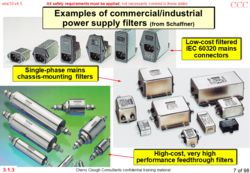A useful solution to the EMC / SAFETY compromise when filtering AC mains
16 Apr 2025
By Keith Armstrong, www.cherryclough.com, 14 April 2025
Summary:
-
Problem: CM emissions versus Safety Risks:
High values of Y-capacitors can reduce conducted common-mode (CM) emissions but can also lead to hazardous levels of mains leakage currents, increasing the risks from electric shocks and tripping safety devices.
-
Solution: Better understand CM current paths:
Conducted common-mode emissions measured at the mains inlet can be suppressed at various points along the noise current loop, not merely at the AC mains inlet alone. Reducing size and cost without increasing mains leakage currents.
Discussion:
In a tradition that probably goes back to the 1920s, an equipment’s common return conductor is usually called ‘Earth’ or ‘Ground’ (even when it does not connect with any soil in which flowers or vegetables could be grown, see https://www.emcstandards.co.uk/clean-earths-aren-t-clean-or-earth).
But anyway, Y-caps values more than a few nF can cause hazardous levels of mains leakage currents to flow in this common return conductor. And when several items of equipment are connected together their leakage currents build up to more hazardous levels.
E.g. In domestic and commercial systems they can build up to cause very dangerous electric shocks; and in rack- or cabinet-mounted systems they can build up to the point where residual current safety protection devices (known as RCCBs, ELCBs, GFCIs, etc.) trip out the mains supply. Such mains trips often appear random – causing possible huge problems with downtime because their causes can be very difficult to find.
A colleague recently showed me how to better understand how to deal with this compromise: “Because all AC currents flow in closed loops*, conducted CM emissions measured by the mains LISN can be suppressed anywhere along their current loop – not only at the AC mains inlet.”
For example, inadequate enclosure and/or cable shielding and/or filtering can allow noise currents to couple into external conductive structures (e.g. the ground reference plane and/or shielding enclosure of an EMC test chamber), from where these noise currents will complete their loops by flowing in the AC mains cable being measured by the LISN.
Now – CM noise suppression at the mains power inlet needs high-voltage safety-rated components – large, heavy and costly. However – suppressing CM emissions at other locations along their noise current loops can as effective for EMC compliance without increasing mains leakage currents (and also help reduce size, weight, and cost).
Most people have problems with this concept (like I did) because we are used to thinking of AC current flow in quasi-static terms, as if it has direction (like a DC current has). But it doesn’t!
Has this helped expand your understanding of EMC and safety?
Expand your knowledge of EMC and safety a great deal more, by attending EMC & CI, this year being held for the first time in the beautiful and vibrant City of Oxford, UK, in May 2025: www.emcandci.com.
Please use my personal 30% Discount Code: EMCSTANDARDS30, when booking on-line.
* For background, revise Kirchoff’s Current Law, and Faraday’s Law of Electromagnetic Induction (which became the ‘Maxwell-Faraday equation’).
Go on, you know how to Google!
Get more from EMC Standards
EMC Standards is a world-leading resource for all things EMC and EMI related. Our website is packed full of both free and paid-for content, including:
- Online quiz
- Webinars
- Training quiz
- And much more!

Electromagnetic Engineering (EMgineering) is the basis for proven good design practices for signal integrity (SI), power integrity (PI), and the control of EMI emissions and immunity (EMC).
Our aim is to help people learn how to more quickly and cost-effectively design and manufacture electronic equipment (products, systems, installations, etc.) to meet functional (i.e. SI/PI) specifications and conform to EMC standards, directives and other requirements.
Such equipment should benefit from reduced warranty costs and financial risks, whilst improving uptime, competitiveness and profitability.
We also cover basic good electrical safety engineering; and the Risk Management of Electromagnetic Disturbances / EMI, whether for Functional Safety or other types of risk.
Join EMC standards TODAY!
